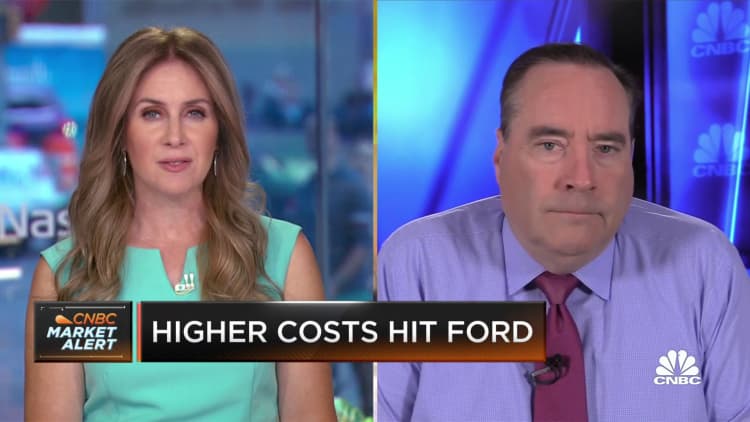Ford’s stock is up more than 70% since Jim Farley became CEO – but he still has a ton of work to do
Ford CEO Jim Farley poses with the Ford F-150 Lightning pickup truck in Dearborn, Michigan, May 19, 2021.
Rebecca Cook | Reuters
DETROIT – As incoming CEO of Ford Motor, Jim Farley promised more transparency to Wall Street as well as a clear plan for the future.
At the time, Ford was considered behind the industry when it came to all-electric and autonomous vehicles, connectivity and software. Its messaging and plans were unclear to Wall Street, causing shares to tumble.
Two years later, Farley, 60, has largely delivered on his promises through the company’s ongoing Ford+ transformation plan, but there remains work to be done.
He has restructured operations and largely brought Wall Street back into the automaker’s corner for the first time since Alan Mulally – credited with saving the automaker from bankruptcy in 2009 – stepped down as CEO eight years ago. Ford’s stock is up about 70% since Farley took over, despite recent declines.
“What matters to us and the team is delivering on strong business results,” said Farley told CNBC in August 2020, when he was announced as incoming CEO. “As far as communicating to Wall Street … one of the most important commitments that we’re making as a team is a clear and specific plan for the company and the company’s transformation.”
Both of Farley’s predecessors – Jim Hackett and Mark Fields – left the automaker amid lackluster stock prices and failing to create confidence in the automaker on Wall Street. Under Hackett, a former CEO of furniture company Steelcase, Ford’s stock price declined by 40%.
But, as Farley routinely says, the automaker remains in the early innings of its Ford+ transformation plan and the industry’s shift to electric vehicles – likely representing the stock’s improvement under Farley but also its recent fall amid a larger market decline. Ford’s stock achieved decades-high prices of more than $25 a share to begin the year, but it’s off about 56% from its peak in January.
There remain doubts about the outlook for the auto industry as well as Ford’s ability to execute on its plans. The company has continued to experience problems with vehicle launches, warranty costs and supply chains – all things Farley vowed to fix upon becoming CEO.
“Key risks to our view relate to Ford’s ability to profitably pivot to growth areas such as EVs and AVs, the auto cycle, market share, and margins (both margin pressure in a downturn and margin expansion longer term from company specific initiatives),” Goldman Sachs analyst Mark Delaney said in a note to investors last week.
Most recently, the company surprised Wall Street by pre-releasing part of its third-quarter earnings report, warning investors of $1 billion in unexpected supplier costs. Since then, shares of the company are down by more than 23%, including its largest daily fall in 11 years a day after the announcement.
Ford Chair Bill Ford and President and CEO Jim Farley converse in front of newly revealed Mustang Dark Horse at The Stampede in downtown Detroit on Sept. 14, 2022.
Ford
“I think the biggest thing he’s done is get the market to believe in Ford again. That belief has perhaps been put on hold now until they show they can meet full year 2022 guidance in light of the Q3 preannounce not being well received at all,” Morningstar analyst David Whiston told CNBC, echoing other analysts.
Whiston describes Farley as a “blunt communicator” who’s “not afraid to take some bold courses of action,” such as internally separating Ford’s traditional and electric vehicle businesses; increasing investments in electric vehicles to $50 billion through 2025; and cost-cutting and headcount reductions.
“He’s also a ‘car guy’ which I like because he has passion for product, which helps get vehicles like the Mach-E as opposed to a crappy (economy box battery-electric vehicle) that no one wants,” Whiston said, before adding he’d like to see fewer recalls and improvement on warranty costs. “But I think Ford is in great hands with Farley in charge.”
Ford’s stock is rated overweight with a price target of $16.12 – roughly $4 more than its current price, according to average estimates of analysts compiled by FactSet.
Here are the stock’s best and worst days during Farley’s tenure as CEO so far:
- Jan. 4, 2022, +11.7%: Ford announces plans to nearly double annual production capacity of its electric F-150 pickup to 150,000 vehicles per year at a plant in Michigan.
- Dec. 10, 2021, +9.6%: Farley tells CNBC Investing Club with Jim Cramer that the company has closed reservations for its electric F-150 Lightning after topping 200,000 units.
- Oct. 28, 2021, +8.7%: Ford nearly doubles Wall Street’s earnings expectations and slightly beats revenue projections for the third quarter, leading the automaker to increase its annual guidance for the second time last year.
- Sept. 20, 2022, -12.3%: Ford pre-releases part of its third-quarter earnings report and warns investors of $1 billion in unexpected supplier costs.
- Feb. 4, 2022, -9.7%: Ford significantly misses Wall Street’s fourth-quarter earnings expectations and slightly misses on revenue.
- April 29, 2021, -9.4%: Ford impresses Wall Street with its first-quarter earnings results, but the company’s lackluster guidance for the year surprises, even confuses, investors and analyst.
– CNBC’s Michael Bloom contributed to this report.

For all the latest business News Click Here

